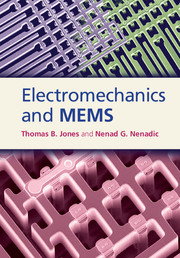Book contents
- Frontmatter
- Contents
- Preface
- 1 Introduction
- 2 Circuit-based modeling
- 3 Capacitive lumped parameter electromechanics
- 4 Small-signal capacitive electromechanical systems
- 5 Capacitive sensing and resonant drive circuits
- 6 Distributed 1-D and 2-D capacitive electromechanical structures
- 7 Practical MEMS devices
- 8 Electromechanics of piezoelectric elements
- 9 Electromechanics of magnetic MEMS devices
- Appendix A Review of quasistatic electromagnetics
- Appendix B Review of mechanical resonators
- Appendix C Micromachining
- Appendix D A brief review of solid mechanics
- Index
- References
9 - Electromechanics of magnetic MEMS devices
Published online by Cambridge University Press: 05 May 2013
- Frontmatter
- Contents
- Preface
- 1 Introduction
- 2 Circuit-based modeling
- 3 Capacitive lumped parameter electromechanics
- 4 Small-signal capacitive electromechanical systems
- 5 Capacitive sensing and resonant drive circuits
- 6 Distributed 1-D and 2-D capacitive electromechanical structures
- 7 Practical MEMS devices
- 8 Electromechanics of piezoelectric elements
- 9 Electromechanics of magnetic MEMS devices
- Appendix A Review of quasistatic electromagnetics
- Appendix B Review of mechanical resonators
- Appendix C Micromachining
- Appendix D A brief review of solid mechanics
- Index
- References
Summary
Preliminaries
For the first century of its existence, the engineering discipline of electromechanics focused almost exclusively on high-current relays, magnetic actuators, and, of course, rotating machines, the latter ranging from fractional horsepower induction motors all the way to gigawatt-rated synchronous alternators [1, 2]. Capacitive transducers never really figured in the discipline because of the focus maintained by the electric power industry on electrical ↔ mechanical power conversion and control. It might seem ironic then that the first eight chapters of this text exclusively concern electrostatic transducers. This emphasis, warranted by the dominance of such devices in the technology of MEMS, testifies to the stern rule of physical scaling in the engineering of useful devices. On the scale of millimeters and below, electrostatic forces hold a considerable advantage.
It would be a mistake, however, to foster the impression that magnetic MEMS will have no role in the future of microsystems technology. They already fill some significant niches in micromechanics and many believe their full potential remains to be tapped. The area-normalized scaling analysis presented in Section A.6 of Appendix A reveals that, based on the present state of materials science and process technology for magnetic materials, the dimensional “break-even” point between capacitive and magnetic MEMS devices is near one millimeter, that is, ~103 microns. This result might seem to suggest that magnetic devices face insurmountable challenges in overtaking capacitive devices in the size range of ~100 microns; however, scaling analyses are prone to the biases built into the assumptions used to formulate them, and as a result, may misrepresent the situation.
- Type
- Chapter
- Information
- Electromechanics and MEMS , pp. 399 - 453Publisher: Cambridge University PressPrint publication year: 2013



